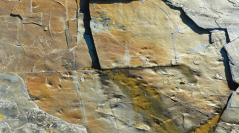

 Comptes Rendus Palevol
22 (19) - Pages 439-453
Comptes Rendus Palevol
22 (19) - Pages 439-453Body fossils have been discovered in the Fortunian deposits of the Rozel Cape, in Normandy (NW France). The material consists of about 80 specimens preserved on a shale surface, recently observed at the base of a cliff at the Cap Rozel, in the Cotentin region. The fossils, centimetric in size, have an elliptical outline, with a peripheral bulge, generally without other conspicuous ornamentation, but showing sometimes concentric or radial lines possibly of taphonomic origins. In addition, these body fossils are preserved parallel to the bedding plane, locally rich in horizontal trace fossils (e.g. Archaeonassa Fenton & Fenton, 1937, Helminthoidichnites Fitch, 1850, Helminthopsis Heer, 1877) and also complex treptichinids burrows (e.g. Treptichnus pedum (Seilacher, 1955)) sometimes associated with microbial mats. The sedimentological characteristics of these deposits (ripple marks, syneresis cracks) correspond to a shallow marine shelf environment, with a variable hydrodynamism in the intertidal zone, low for surfaces showing elliptic fossils and syneresis cracks, higher for surfaces with ripple marks. These new discoveries unravel the potential of the Fortunian strata from Normandy and provide new information about the early Cambrian biocenoses.
Elliptical body fossils, Fortunian, Normandy, NW France.